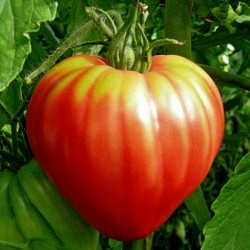Menu
-
Menuالعدمة
- Home
-
التصنيفات
-
-
التصنيفات
-
بذور الخضروات
-
أصناف حسب البلد
- أصناف من أرمينيا
- أصناف من البوسنة والهرسك
- أصناف من كرواتيا
- أصناف من فرنسا
- أصناف من ألمانيا
- أصناف من اليونان
- أصناف من المجر
- أصناف من الهند
- أصناف من إيطاليا
- أصناف من اليابان
- أصناف من شمال مقدونيا
- أصناف من بيرو
- أصناف من روسيا
- أصناف من صربيا
- أصناف من سلوفينيا
- أصناف من اسبانيا
- أصناف من تايلاند
- أصناف من تركيا
- أصناف من الولايات المتحدة الأمريكية
- بذور الطماطم
- بذور الذرة
- عائلة القرع
- الفول الأسرة
- بذور الخيار
- بذور الفلفل
- عائلة الجزرة
- عائلة البصل
- بذور الخس
- عائلة البطاطس
- عائلة الملفوف
- بذور الفجل
- عائلة الشمندر
- بذور البطيخ
- بذور بطيخ
- بذور القرنبيط
- عائلة عباد الشمس
-
أصناف حسب البلد
- بذور الفاكهة
- بذور الفلفل الحار
- بذور عشبة طبية
- تسلق بذور النباتات
- الأشجار - بذور بونساي
- بذور النخيل
- بذور الأعشاب الزينة
- بذور التبغ
-
بذور الخضروات
-
-
-
-
- منتجات جديدة
- التسليم - الدفع
- انشئ حساب
- FAQ
- الصفحة الرئيسية
-
- حزم كبيرة من البذور
- بذور النباتات العملاقة
- بذور الخضروات
- أصناف حسب البلد
- أصناف من أرمينيا
- أصناف من البوسنة والهرسك
- أصناف من كرواتيا
- أصناف من فرنسا
- أصناف من ألمانيا
- أصناف من اليونان
- أصناف من المجر
- أصناف من الهند
- أصناف من إيطاليا
- أصناف من اليابان
- أصناف من شمال مقدونيا
- أصناف من بيرو
- أصناف من روسيا
- أصناف من صربيا
- أصناف من سلوفينيا
- أصناف من اسبانيا
- أصناف من تايلاند
- أصناف من تركيا
- أصناف من الولايات المتحدة الأمريكية
- بذور الطماطم
- بذور الذرة
- عائلة القرع
- الفول الأسرة
- بذور الخيار
- بذور الفلفل
- عائلة الجزرة
- عائلة البصل
- بذور الخس
- عائلة البطاطس
- عائلة الملفوف
- بذور الفجل
- عائلة الشمندر
- بذور البطيخ
- بذور بطيخ
- بذور القرنبيط
- عائلة عباد الشمس
- أصناف حسب البلد
- بذور الفاكهة
- بذور الفلفل الحار
- بذور عشبة طبية
- تسلق بذور النباتات
- الأشجار - بذور بونساي
- بذور الموز
- بذور النخيل
- بذور الأعشاب الزينة
- بذور التبغ
- بذور زهرة
- بذور الصبار
- بذور النباتات المائية
- تعليمات البذر
- قوالب الفاكهة والخضروات
- فطر الفطر
- المصابيح النباتية
- بذور الخيزران
- نباتات الأيورفيدا
- F1 hybrid seeds
- التعبئة والتغليف والاشياء
- نباتات مقاومة للبرد
- منتجات العناية النباتية
- التوابل العضوية
- التسليم - الدفع
- لا دفع باي بال وبطاقة X
Last Product Reviews
Out of the two seeds, one germinated and the other one was dead and floatin...
By
 Riikka H on 07/03/2024
Riikka H on 07/03/2024
Verified Purchase
الأكثر مبيعاً
يوجد 1294 منتجا.
عرض 571-585 من 1294 منتجات

متنوعة من المجر
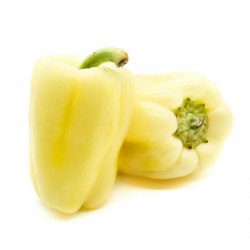
الهنغارية بذور الفلفل الحلو...
السعر
1.85 €
(SKU: PP 23)
Seeds Gallery EU,
5/
5
<meta http-equiv="Content-Type" content="text/html; charset=UTF-8" />
<h2><strong>الهنغارية بذور الفلفل الحلو Albaregia</strong></h2>
<h2><span style="color: #ff0000;"><strong>ثمن عبوة 20 بذرة.</strong></span></h2>
<p>مجموعة فلفل حلو تنضج مبكرًا وعالية النضج في هنغاريا ، وهي أكثر مقاومة من الصنف الأساسي بسبب الزراعة الحيوية. البارجيا هو فلفل حلو نموذجي.</p>
<p>تنضج الثمرة البيضاء إلى برتقالي أحمر. ثمارها كبيرة ، منتصبة ، حلوة ، مضلعة قليلاً ، بمتوسط وزن 170 جرام ، ذو بشرة سميكة ولذيذة. ممتاز للاستهلاك الطازج ومحشو.</p>
PP 23 (20 S)

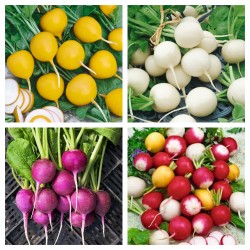
بذور الفجل ثلاثية الألوان
السعر
2.50 €
(SKU: VE 224)
Seeds Gallery EU,
5/
5
<meta http-equiv="Content-Type" content="text/html; charset=UTF-8" />
<h2><strong>بذور الفجل ثلاثية الألوان</strong></h2>
<h2><span style="color: #ff0000;"><strong>ثمن عبوة 50 بذرة.</strong></span></h2>
<p>ثلاثة أنواع مختلفة من الفجل الملون ممتازة لزراعة الربيع والخريف.<br />طور Albena الأبيض ، Zlata البني المصفر ، و Viola تطور الدرنات الأرجواني. جميع الأصناف في وقت مبكر للغاية ومنتجة للغاية مع ثمار كبيرة.</p>
VE 224 (50 S)

- على الإنترنت فقط!

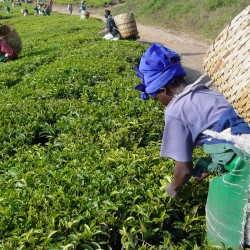
كاميليا صينية بذور
السعر
6.95 €
(SKU: MHS 3)
Seeds Gallery EU,
5/
5
<!DOCTYPE html>
<html>
<head>
<meta http-equiv="Content-Type" content="text/html; charset=UTF-8" />
</head>
<body>
<h2><strong>كاميليا صينية بذور</strong></h2>
<h2><span style="color: #ff0000;"><strong>ثمن حزمة من 3 البذور.</strong></span></h2>
<p><strong>الكاميليا الصينية</strong> (الاسم العلمي: <span dir="ltr">Camellia sinensis</span>) وهي نوع من النباتات التي تستخدم أوراقه وبراعمه لإنتاج المشروب الشعبي <strong>الشاي</strong>. وتعد من جنس الكاميليا أحد أجناس النباتات المزهرة من فصيلة ثياسي. ينتج منها أنواع مختلفة من الشاي مثل : الشاي الأبيض، الشاي الأصفر، الشاي الأخضر، شاي الأولونج، شاي بوير والشاي الأسود جميع هذه الأنواع يتم معالجتها بشكل مختلف لتحقيق مستويات مختلفة من الأكسدة. يقطف شاي كوكيشا (شاي الأغصان) من نفس النوع "الكاميليا الصينية" ولكن تستخدم الأغصان والسيقان بدلا من الأوراق، وتشمل الأسماء الشائعة نبات الشاي، وشجيرة الشاي، وشجرة الشاي (وينبغي عدم الخلط بينها وبين ميلالوكا رفيعة الأوراق، التي تعد مصدر زيت شجرة الشاي).</p>
<h2><strong>إنبات نبات الشاي من البذور</strong></h2>
<p><iframe width="640" height="385" src="https://www.youtube.com/embed/Dh9dhkOBynw?rel=0&hd=1" frameborder="0" allowfullscreen="allowfullscreen" class="embed-responsive-item"> </iframe>
<script type="text/javascript"></script>
</p>
</body>
</html>
MHS 3


متنوعة من صربيا
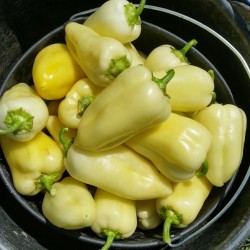
ماتيكا بذور الفلفل الحلو
السعر
1.85 €
(SKU: PP 69)
Seeds Gallery EU,
5/
5
<h2 class=""><strong>ماتيكا بذور الفلفل الحلو</strong></h2>
<h2><span style="color: #ff0000;"><strong>ثمن حزمة من 60 البذور.</strong></span></h2>
<p>ماتيكا الفلفل الحلو هي واحدة من الأصناف المفضلة في وقت متأخر الصربية في صربيا. الفاكهة لها شكل مخروطي مع طرف واحد ، تذكرنا الأصناف القديمة Somborka الأصلي ، ولكن الفلفل الحلو. وزن الثمرة 70-100 جم وسمك الفحّار 5-6 مم.</p>
<p>في النضج التكنولوجي ، تكون الثمرة من اللون الأخضر الفاتح إلى الأصفر ، وفي اللون الأحمر الفسيولوجي المكثف.</p>
<p>مجموعة متنوعة مفضلة للفلفل المخبوزة ، لأنه من السهل فصل الجلد عن لحم الثمرة ، وبالتالي فهو المفضل لدى ربات البيوت في صربيا.</p>
<script src="//cdn.public.n1ed.com/G3OMDFLT/widgets.js"></script>
PP 69 (60 S)


متنوعة من صربيا
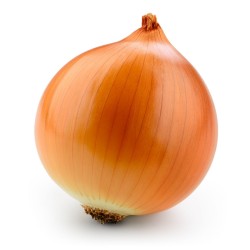
بذور البصل Kupusinski...
السعر
1.70 €
(SKU: MHS 150)
Seeds Gallery EU,
5/
5
<meta http-equiv="Content-Type" content="text/html; charset=UTF-8" />
<h2><strong>بذور البصل Kupusinski Jabucar (بصل التفاح)</strong></h2>
<h2 dir="rtl"><span style="color: #ff0000;"><strong>ثمن حزمة من 100 البذور.</strong></span></h2>
<p>Kupusinski jabučar هي مجموعة صربية قديمة ، وأحد الأصناف القديمة المفضلة لمبة الفاكهة على شكل تفاحة (ومن هنا جاءت تسميتها Kupusinski jabučar) ، مع رقبة صلبة مغلقة جيدًا. أوراق غمد صفراء داكنة اللون. يمكن تخزين هذا التنوع لفترة طويلة ، دون أن يفقد طعمه.</p>
<p>"Kupusinski jabučar" المترجمة إلى الإنجليزية "Apple Onion aus Kupusina" (كوبوسينا هي قرية في صربيا).</p>
<p>ينمو الصنف المتوسط الحار بنجاح من البذور. متوسط كتلة لمبة الفاكهة هو 80-120 غرام.</p>
<p>محتوى المادة الجافة هو 12-14 ٪. ينتج عنه حوالي 300 مول / هكتار.</p>
<p>
<script type="text/javascript"></script>
</p>
MHS 150 (100 S)


متنوعة من صربيا
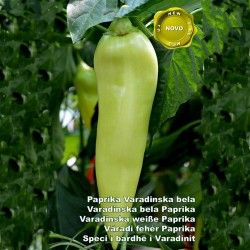
Varadinska White pepper seeds
السعر
1.65 €
(SKU: P 47)
Seeds Gallery EU,
5/
5
<h2><strong>Varadinska White pepper seeds</strong></h2>
<h2><span style="color: #ff0000;"><strong>Price for Package of 20 seeds.</strong></span></h2>
<p>Varadinska White pepper is a variety from Serbia. An early variety of pepper (from sprouting to technological maturity 118-120 days to biological 135-140 days), with long and large fruits. Excellent sweet taste, juicy, and crispy. Perfect for fresh consumption, barbeque, cooking, pickling. One of the favorite varieties in Serbia for making <span style="color: #0000ff;"><a href="https://www.google.com/search?q=lu%C4%8Dene+paprike&oq=lu%C4%8Dene+paprike&aqs=chrome..69i57j69i60&sourceid=chrome&ie=UTF-8" target="_blank" title=""lučene paprike"" style="color: #0000ff;" rel="noreferrer noopener"><strong>"lučene paprike"</strong></a></span></p>
<p>At full technological maturity, the fruits are milky white in color, while in biological ones they are intensely red. The plant forms hanging fruits 20-24cm long, 5-6 cm wide, 4-5mm thick meat-pericarp with an average weight of 120-130 grams.</p>
<p>It is suitable for year-round production in a protected area and achieves an extremely high yield potential in the open field (40-45 t / ha), with the application of appropriate agro-technical measures.</p>
P 47 (20 S)

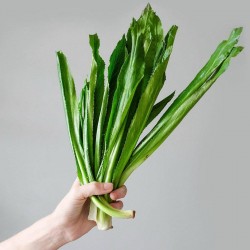
(Eryngium foetidum) قرصعنة...
السعر
1.95 €
(SKU: MHS 32)
Seeds Gallery EU,
5/
5
<meta http-equiv="Content-Type" content="text/html; charset=UTF-8" />
<h2><strong>(Eryngium foetidum) قرصعنة كريهة الرائحة بذور</strong></h2>
<h2><span style="color: #ff0000;"><strong>ثمن عبوة من 20 بذرة. </strong></span></h2>
<p>القِرصَعنة كريهة الرائحة أو الكزبرة الطويلة نوع نباتي عشبي يتبع جنس القِرصَعنة من الفصيلة الخيمية. موطنه الأصلي المكسيك وأمريكا الجنوبية.</p>
<p>Eryngium foetidum is a tropical perennial herb in the family Apiaceae. Common names include culantro , recao, shadow beni, Mexican coriander, bhandhania, long coriander, sawtooth coriander, and ngò gai. It is native to Mexico, the Caribbean, Central and South America, but is cultivated worldwide, sometimes being grown as an annual in temperate climates.</p>
<p>In the United States, the common name culantro sometimes causes confusion with cilantro, a common name for the leaves of Coriandrum sativum (also in Apiaceae), of which culantro is said to taste like a stronger version.</p>
<p><strong>Uses</strong></p>
<p><strong>Culinary</strong></p>
<ol>
<li>foetidum is widely used in seasoning, marinating and garnishing in the Caribbean, particularly in Cuba, Dominican Republic, Puerto Rico, Trinidad and Tobago, Panama, Guyana, Suriname, and in Ecuador and Peru's Amazon regions. It is used extensively in Cambodia, Thailand, India, Vietnam, Laos,Myanmar and other parts of Asia as a culinary herb.[5] It dries well, retaining good color and flavor, making it valuable in the dried herb industry. It is sometimes used as a substitute for coriander, but it has a much stronger taste.</li>
</ol>
<p> </p>
<p>In the United States, E. foetidum grows naturally in Florida, Georgia, Hawaii, Puerto Rico, and the Virgin Islands.</p>
<p><strong>Traditional medicine</strong></p>
<ol>
<li>foetidum has been used in traditional medicine in tropical regions for burns, earache, fevers, hypertension, constipation, fits, asthma, stomachache, worms, infertility complications, snake bites, diarrhea, and malaria.</li>
<li>foetidum is also known as E. antihystericum.[8] The specific name antihystericum reflects the fact that this plant has traditionally been used for epilepsy.[9] The plant is said to calm a person's 'spirit' and thus prevents epileptic 'fits', so is known by the common names spiritweed and fitweed. The anticonvulsant properties of this plant have been scientifically investigated.[10][medical citation needed] A decoction of the leaves has been shown to exhibit anti-inflammatory and analgesic effects in rats.</li>
</ol>
<p>Eryngial is a chemical compound isolated from E. foetidum.[12] The University of the West Indies at Mona, Jamaica, has investigated the use of enyngial as a treatment for human Strongyloides stercoralis infection (strongyloidiasis).</p>
<p>It is used as an ethnomedicinal plant for the treatment of a number of ailments such as fevers, chills, vomiting, burns, fevers, hypertension, headache, earache, stomachache, asthma, arthritis, snake bites, scorpion stings, diarrhea, malaria and epilepsy.[medical citation needed] The main constituent of essential oil of the plant is eryngial (E-2-dodecenal). A pharmacological investigation claims to have demonstrated anthelmintic, anti-inflammatory, analgesic, anticonvulsant, anticlastogenic, anticarcinogenic, antidiabetic, and antibacterial activity.</p>
<p> </p>
MHS 32 (20 S)


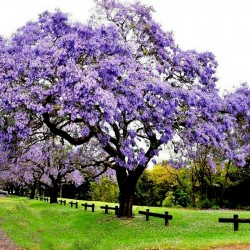
500 بذور شجرة الاميرة -...
السعر
9.00 €
(SKU: T 14 T)
Seeds Gallery EU,
5/
5
<!DOCTYPE html>
<html>
<head>
<meta http-equiv="Content-Type" content="text/html; charset=UTF-8" />
</head>
<body>
<h2><strong>500 بذور شجرة الاميرة - Paulownia tomentosa - بولفينية كثة الزغب</strong></h2>
<h2><span style="color: #ff0000;"><strong>ثمن عبوة 500 حبة.</strong></span></h2>
<p>Paulownia tormentosa is known by many names; regardless of what you want to call it, there is no doubt about its impressive ornamental features. This beautiful tree puts on an awe-inspiring show in spring. Its soft chamois velvet buds open into large violet to blue, trumpet-like blossoms that fill the air with a sweet fragrance. The flowers carried on long up curved shoots, look like large foxgloves.</p>
<p>The huge leaves are an architectural delight: the soft, downy, large leaves appear after the flowers have opened.</p>
<p>Native to eastern Asia, this exotic looking, deciduous tree is surprisingly hardy and can tolerate harsh winters, to - 8*C (-14*F). Hardy throughout the British Isles, the buds of the Foxglove-like flowers are formed in the autumn and can be damaged by late frosts. They must be sheltered from hard frosts to ensure the violet blooms appear in spring.</p>
<div>
<div>It is a fast growing tree, usually grown as a specimen or shade tree. Growing rapidly (to 6f)t in it first year. In 3-5 years, this tree achieves what many other tree species take generations to achieve. An excellent use of this plant is the production of "stooled" specimens giving perhaps the most magnificent of all foliage dot plants. All growth is cut down to ground level each March and the resultant suckers reduced to a single shoot. The result is a strong, erect growth rising to 10 ft. and bearing huge and handsome leaves, producing a most striking effect. In very cold zones they are often grown and cut to near ground level in autumn and grown as a large-leafed shrub the following season.</div>
<div>Very easy to germinate, seedlings grow rapidly, flowering in as little as 2-3 years under good growing conditions.</div>
<div>It has been awarded the prestigious RHS Award of Garden Merit.</div>
<div>Named after the Princess of the Dutch region, Anna Paulowna, who died in 1865. It has never been found in the wild although it undoubtedly originated in China where an old custom is to plant an Empress Tree when a baby girl is born. The fast-growing tree matures as she does. When she is eligible for marriage the tree is cut down and carved into wooden articles for her dowry. Carving the wood of Paulownia is an art form in Japan and China.</div>
<div>Sowing: </div>
<div>Sow September to May</div>
<div>The seeds are very small so sow as thinly as possible to avoid crowding which leave seedlings more susceptible to damping off. Place the seeds on the surface of a tray containing well drained compost. Do not cover the seeds as light is required for germination.</div>
<div>Stand the tray in water to soak and either cover with a plastic dome or place the tray into a plastic bag. Temperatures should ideally not exceed 30*C (85*F) during the daytime and not below 18*C (60*F) at night. Always keep the soil mixture moist (not soaked) during the germination process. The seeds will germinate in 30 – 60 days and grow rapidly when conditions are favourable.</div>
<div>Growing: </div>
<div>After germination, remove the cover or bag. When seedlings are big enough to handle (about 2-3 weeks), carefully transfer to pots. Grow on until they are strong enough to plant into their permanent positions. Harden off before planting out (after the last expected frosts).</div>
<div>Aftercare: </div>
<div>Pruning should be done in autumn after leaf drop. prune down to where an axillary bud can take over as the single leader. Coppicing a tree annually sacrifices the flowers but produces 3m (10ft) stems with enormous leaves up to 60cm (2ft) across.</div>
<div>Plant Uses: </div>
<div>A specimen tree, shade tree, or focal point.</div>
<span style="font-size: 11px; line-height: 1.5em;">Fully hardy to -25°C.</span></div>
<div>
<table cellspacing="0" cellpadding="0" border="1">
<tbody>
<tr>
<td colspan="2" width="100%" valign="top">
<p><span style="color: #008000;"><strong>Sowing Instructions</strong></span></p>
</td>
</tr>
<tr>
<td valign="top" nowrap="nowrap">
<p><span style="color: #008000;"><strong>Propagation:</strong></span></p>
</td>
<td valign="top">
<p><span style="color: #008000;">Seeds</span></p>
</td>
</tr>
<tr>
<td valign="top" nowrap="nowrap">
<p><span style="color: #008000;"><strong>Pretreat:</strong></span></p>
</td>
<td valign="top">
<p><span style="color: #008000;">0</span></p>
</td>
</tr>
<tr>
<td valign="top" nowrap="nowrap">
<p><span style="color: #008000;"><strong>Stratification:</strong></span></p>
</td>
<td valign="top">
<p><span style="color: #008000;">0</span></p>
</td>
</tr>
<tr>
<td valign="top" nowrap="nowrap">
<p><span style="color: #008000;"><strong>Sowing Time:</strong></span></p>
</td>
<td valign="top">
<p><span style="color: #008000;">all year round </span></p>
</td>
</tr>
<tr>
<td valign="top" nowrap="nowrap">
<p><span style="color: #008000;"><strong>Sowing Depth:</strong></span></p>
</td>
<td valign="top">
<p><span style="color: #008000;">Light germinator! Only sprinkle on the surface of the substrate + slightly press on</span></p>
</td>
</tr>
<tr>
<td valign="top" nowrap="nowrap">
<p><span style="color: #008000;"><strong>Sowing Mix:</strong></span></p>
</td>
<td valign="top">
<p><span style="color: #008000;">Coir or sowing mix + sand or perlite</span></p>
</td>
</tr>
<tr>
<td valign="top" nowrap="nowrap">
<p><span style="color: #008000;"><strong>Germination temperature:</strong></span></p>
</td>
<td valign="top">
<p><span style="color: #008000;">22-25°C</span></p>
</td>
</tr>
<tr>
<td valign="top" nowrap="nowrap">
<p><span style="color: #008000;"><strong>Location:</strong></span></p>
</td>
<td valign="top">
<p><span style="color: #008000;">bright + keep constantly moist not wet</span></p>
</td>
</tr>
<tr>
<td valign="top" nowrap="nowrap">
<p><span style="color: #008000;"><strong>Germination Time:</strong></span></p>
</td>
<td valign="top">
<p><span style="color: #008000;">4-6 weeks</span></p>
</td>
</tr>
<tr>
<td valign="top" nowrap="nowrap">
<p><span style="color: #008000;"><strong>Watering:</strong></span></p>
</td>
<td valign="top">
<p><span style="color: #008000;">Water regularly during the growing season</span></p>
</td>
</tr>
<tr>
<td valign="top" nowrap="nowrap">
<p><span style="color: #008000;"><strong> </strong></span></p>
</td>
<td valign="top">
<p><br /><span style="color: #008000;"><em>Copyright © 2012 Seeds Gallery - Saatgut Galerie - Galerija semena. </em><em>All Rights Reserved.</em><em></em></span></p>
</td>
</tr>
</tbody>
</table>
</div>
</body>
</html>
T 14 T

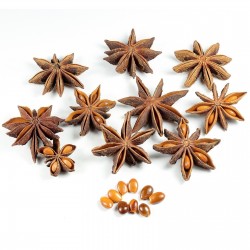
Star Anise Seeds (Illicium...
السعر
3.50 €
(SKU: MHS 116)
Seeds Gallery EU,
5/
5
<h2 class=""><strong>Star Anise Seeds (Illicium verum)</strong></h2>
<h2><span style="color: #ff0000;"><strong>Price for Package of 3 seeds.</strong></span></h2>
<p><i><b>Illicium verum</b></i><span> </span>is a medium-sized<span> </span>evergreen<span> </span>tree native to northeast<span> </span>Vietnam<span> </span>and southwest China. A spice commonly called<span> </span><b>star anise</b>,<span> </span><b>staranise</b>,<span> </span><b>star anise seed</b>,<span> </span><b>Chinese star anise</b>, or<span> </span><b>badiane</b><span> </span>that closely resembles<span> </span>anise<span> </span>in flavor is obtained from the star-shaped<span> </span>pericarps<span> </span>of the fruit of<span> </span><i>I. verum</i><span> </span>which are harvested just before ripening. Star anise oil is a highly fragrant oil used in cooking, perfumery, soaps, toothpastes, mouthwashes, and skin creams. About 90% of the world's star anise crop is used for extraction of<span> </span>shikimic acid, a chemical intermediate used in the synthesis of<span> </span>oseltamivir<span> </span>(Tamiflu).</p>
<h2><span class="mw-headline" id="Nomenclature">Nomenclature</span></h2>
<table class="infobox">
<tbody>
<tr>
<td colspan="2">Star anise</td>
</tr>
<tr>
<th scope="row">Chinese</th>
<td><span lang="zh-hani" title="Chinese language text" xml:lang="zh-hani">八角</span></td>
</tr>
<tr>
<th scope="row">Literal meaning</th>
<td>"eight-horns"</td>
</tr>
<tr>
<td colspan="2">
<table class="collapsible collapsed mw-collapsible mw-collapsed mw-made-collapsible">
<tbody>
<tr>
<th colspan="2"><span class="mw-collapsible-toggle mw-collapsible-toggle-default mw-collapsible-toggle-collapsed">show</span>Transcriptions</th>
</tr>
</tbody>
</table>
</td>
</tr>
</tbody>
</table>
<p><i>Illicium</i><span> </span>comes from the Latin<span> </span><i>illicio</i><span> </span>meaning "entice". In<span> </span>Persian, star anise is called<span> </span><span lang="fa" title="Persian language text" xml:lang="fa">بادیان</span><span> </span><i>bādiyān</i>, hence its French name<span> </span><i><i>badiane</i></i>.</p>
<h2><span class="mw-headline" id="Use">Use</span></h2>
<h3><span class="mw-headline" id="Culinary_use">Culinary use</span></h3>
<div class="thumb tright">
<div class="thumbinner"><img alt="" src="https://upload.wikimedia.org/wikipedia/commons/thumb/a/aa/Star_Aniseed_back.jpg/220px-Star_Aniseed_back.jpg" width="220" height="190" class="thumbimage" />
<div class="thumbcaption">
<div class="magnify"></div>
Reverse side of fruit</div>
</div>
</div>
<div class="thumb tright">
<div class="thumbinner"><img alt="" src="https://upload.wikimedia.org/wikipedia/commons/thumb/f/f2/Illicium_verum00.jpg/220px-Illicium_verum00.jpg" width="220" height="396" class="thumbimage" />
<div class="thumbcaption">
<div class="magnify"></div>
Plate from<span> </span>François-Pierre Chaumeton's 1833<span> </span><i>Flore Medicale</i></div>
</div>
</div>
<p>Star anise contains<span> </span>anethole, the same compound that gives the unrelated<span> </span>anise<span> </span>its flavor. Recently, star anise has come into use in the<span> </span>West<span> </span>as a less expensive substitute for anise in baking, as well as in<span> </span>liquor<span> </span>production, most distinctively in the production of the<span> </span>liqueur<span> </span>Galliano.<sup id="cite_ref-2" class="reference">[2]</sup><span> </span>Star anise enhances the flavour of meat.</p>
<p>It is used as a spice in preparation of<span> </span><i>biryani</i><span> </span>and<span> </span><i>masala chai</i><span> </span>all over the<span> </span>Indian subcontinent. It is widely used in<span> </span>Chinese cuisine, and in<span> </span>Malay<span> </span>and<span> </span>Indonesian cuisines. It is widely grown for commercial use in China, India, and most other countries in Asia. Star anise is an ingredient of the traditional<span> </span>five-spice powder<span> </span>of Chinese cooking. It is also a major ingredient in the making of<span> </span><i>phở</i>, a<span> </span>Vietnamese<span> </span>noodle soup.</p>
<p>It is also used in the French recipe of mulled wine, called<span> </span><i>vin chaud</i><span> </span>(hot wine). If allowed to steep in coffee, it deepens and enriches the flavor. The pods can be used in this manner multiple times by the pot-full or cup, as the ease of extraction of the taste components increases with the permeation of hot water.</p>
<h3><span class="mw-headline" id="Drug_precursor">Drug precursor</span></h3>
<div class="hatnote navigation-not-searchable">Main article:<span> </span>Oseltamivir total synthesis</div>
<p>Star anise is the major source of the chemical compound<span> </span>shikimic acid, a primary<span> </span>precursor<span> </span>in the<span> </span>pharmaceutical<span> </span>synthesis of the antiinfluenza<span> </span>drug,<span> </span>oseltamivir<span> </span>(Tamiflu).<sup id="cite_ref-Bilal_4-0" class="reference">[4]</sup><sup id="cite_ref-Drugs_5-0" class="reference">[5]</sup><sup id="cite_ref-Wang_6-0" class="reference">[6]</sup>An industrial method for the production of shikimic acid using<span> </span>fermentation<span> </span>of<span> </span><i>E. coli</i><span> </span>bacteria was discovered in 2005,<sup id="cite_ref-7" class="reference">[7]</sup><sup id="cite_ref-8" class="reference">[8]</sup><span> </span>and applied in the<span> </span>2009 swine flu outbreak<span> </span>to address Tamiflu shortages, also causing price increases for star anise as a<span> </span>raw material<span> </span>of shikimic acid.<sup id="cite_ref-lim_9-0" class="reference">[9]</sup><span> </span>As of 2018, fermentation of<span> </span><i>E. coli</i><span> </span>was the manufacturing process of choice to produce shikimic acid for synthesis of Tamiflu.<sup id="cite_ref-Drugs_5-1" class="reference"></sup></p>
<h2><span class="mw-headline" id="Toxicity">Toxicity</span></h2>
<p>Japanese star anise<span> </span>(<i>Illicium anisatum</i>), a similar tree, is highly toxic and inedible; in Japan, it has instead been burned as<span> </span>incense. Cases of illness, including "serious<span> </span>neurologicaleffects, such as seizures", reported after using star anise tea, may be a result of deliberate<span> </span>economically motivated adulteration<span> </span>with this species. Japanese star anise contains the<span> </span>neurotoxin<span> </span>anisatin,<sup id="cite_ref-PubChem_10-0" class="reference">[10]</sup><span> </span>which also causes severe<span> </span>inflammation<span> </span>of the<span> </span>kidneys<span> </span>(nephritis),<span> </span>urinary tract, and<span> </span>digestive organs<span> </span>when ingested.</p>
<p>Swamp star anise<span> </span><i>Illicium parviflorum</i><span> </span>is a similar tree found in the Southern United States, and due to its toxicity, it should not to be used for folk remedies or as a cooking ingredient.</p>
<h2><span class="mw-headline" id="Standardization_of_its_products_and_services">Standardization of its products and services</span></h2>
<ul>
<li>ISO 676:1995 - contains the information about the nomenclature of the variety and cultivars</li>
</ul>
<h3><span class="mw-headline" id="Identification">Identification</span></h3>
<ul>
<li>Refer to the 4th edition of the<span> </span><i>European Pharmacopoeia</i><span> </span>(1153)</li>
</ul>
<h3><span class="mw-headline" id="Differentiation_from_other_species">Differentiation from other species</span></h3>
<p>Joshi<span> </span><i>et al.</i><span> </span>have used<span> </span>fluorescent microscopy<span> </span>and<span> </span>gas chromatography<sup id="cite_ref-reiivh_14-0" class="reference">[14]</sup><span> </span>to distinguish the species, while Lederer<span> </span><i>et al.</i><span> </span>employed<span> </span>thin layer chromatography<span> </span>with<span> </span>HPLC-MS/MS</p>
<p><span style="color: inherit; font-family: inherit; font-size: 30px;">How to Grow Star Anise From Seeds</span></p>
<p>Star anise trees (<em>Illicium verum</em>) grow easily from seed. Star anise trees grow in U.S. Department of Agriculture plant hardiness zones 7 through 10 and do best with a soil pH between 4 and 6 that's rich in organic matter. They grow in either full sun or part shade.</p>
<p><span style="color: inherit; font-family: inherit; font-size: 30px;">Preparing and Planting Star Anise Seeds</span></p>
<p>Carefully preparing and planting the seeds will give the best chance of success. Or, store the seeds in moist sand in a sealed plastic bag or container in the refrigerator for up to a month.</p>
<p><span style="color: inherit; font-family: inherit; font-size: 30px;">Step 1</span></p>
<p>Pour seed-starting potting mix into 4- to 6-inch-diameter plastic pots. Fill them to 1 to 1 1/2 inches from the top. Moisten the mix with room-temperature water. Use pots that have drainage holes in them.</p>
<p><span style="color: inherit; font-family: inherit; font-size: 30px;">Step 2</span></p>
<p>Place the seeds into a bowl filled with water. Throw away any seeds that <strong>float</strong> to the surface. They are not viable. Plant only the seeds that sink to the bottom.</p>
<p><span style="color: inherit; font-family: inherit; font-size: 30px;">Step 3</span></p>
<p>Place two or three seeds per pot on top of the moistened potting mix, spaced evenly apart. Cover the seeds with a 1/4 to 1/2 inch of a moistened seed-starting mix. Firm it gently with your fingers to remove air pockets. Set plastic water or soda bottle with the bottom cut out over the seeds. Leave the screw caps on.</p>
<p><span style="color: inherit; font-family: inherit; font-size: 30px;">Step 4</span></p>
<p>Put the containers in bright, indirect light where temperatures stay around 70 degrees Fahrenheit. Moisten the potting mix using a spray bottle with room-temperature water if it begins to dry or set the containers in 1 to 2 inches of room-temperature water for an hour or two. The water will soak up into the germination mix through the holes in the bottoms of the containers.</p>
<p><span style="color: inherit; font-family: inherit; font-size: 30px;">Step 5</span></p>
<p>Remove the screw caps from the tops of the bottles after the seeds germinate. Remove the bottles a week later. The seeds should germinate in <strong>one to two months</strong>.</p>
<p><span style="color: inherit; font-family: inherit; font-size: 30px;">Step 6</span></p>
<p>Pot the star anise tree seedlings up in individual 6- to 8-inch pots when they are 3 to 4 inches tall. Use pots with drainage holes. Pot them up using <strong>peat-based</strong> potting soil. Set them in bright, indirect light and water them with room-temperature water when the top of the potting soil begins to dry.</p>
<p><span style="color: inherit; font-family: inherit; font-size: 30px;">Step 7</span></p>
<p>Grow the star anise plants in their containers for one year. Repot them into containers 1 inch larger when they become pot-bound or when you can see the roots through the drain holes in the bottom of the container. <strong>Set them outdoors</strong> during the day in the summer when there is no danger of frost and the weather is calm and pleasant. Put them in bright shade in an area that is protected from strong winds. Continue to water them when the top of the soil begins to dry.</p>
<p><span style="color: inherit; font-family: inherit; font-size: 30px;">Step 8</span></p>
<p>Plant them outdoors in their permanent positions the following spring after any danger of frost has passed. Begin to get them used to direct sunlight two weeks before planting. Start with an hour of direct morning sunlight and increase the duration by 30 minutes or so every two days. Water them when the top 2 inches of soil feel dry. Plant multiple trees 15 to 20 feet apart. Water them generously right after planting and continue to water them as often as necessary to keep the soil lightly moist.</p>
<script src="//cdn.public.n1ed.com/G3OMDFLT/widgets.js"></script>
MHS 116 (3 S)

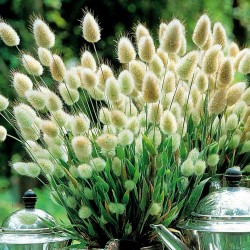
Hare's-tail Grass,...
السعر
1.65 €
(SKU: UT 15)
Seeds Gallery EU,
5/
5
<!DOCTYPE html>
<html>
<head>
<meta http-equiv="Content-Type" content="text/html; charset=UTF-8" />
</head>
<body>
<h2><strong>Hare's-tail Grass, Bunnytail Seeds (Lagurus ovatus)</strong></h2>
<h2><span style="color: #ff0000;"><strong>Price for Package of 10 seeds.</strong></span></h2>
<p><i><b>Lagurus</b></i><span> </span>is a genus of<span> </span>Old World<span> </span>plants in the<span> </span>grass family, native to the<span> </span>Mediterranean Basin<span> </span>and nearby regions, from<span> </span>Azores<span> </span>and the<span> </span>Canary Islands<span> </span>to<span> </span>Crimea<span> </span>and<span> </span>Saudi Arabia. It is also naturalized in<span> </span>Australia,<span> </span>New Zealand,<span> </span>Ireland<span> </span>and<span> </span>Great Britain, and scattered locations in the<span> </span>Americas.<span> </span>The only known species is<span> </span><i><b>Lagurus ovatus</b></i>, commonly called<span> </span><b>hare's-tail</b>,<sup id="cite_ref-BSBI07_4-0" class="reference"></sup><span> </span><b>hare's-tail grass</b><span> </span>or<span> </span><b>bunnytail</b>.<sup id="cite_ref-RHSAZ_5-0" class="reference"></sup><span> </span>It is also grown as an<span> </span>ornamental plant<span> </span>for its attractive flower panicles.<sup id="cite_ref-6" class="reference"></sup></p>
<h2><span class="mw-headline" id="Description">Description</span></h2>
<p><i>Lagurus ovatus</i><span> </span>is a clump-forming<span> </span>annual<span> </span>growing to 50 cm (20 in) tall by 30 cm (12 in) tall, with pale green grassy foliage and numerous short, oval green flowerheads, turning to a buff colour as they ripen, all summer long.<sup id="cite_ref-RHSAZ_5-1" class="reference"></sup><sup id="cite_ref-8" class="reference"></sup></p>
<div class="thumb tright">
<div class="thumbinner"><img alt="" src="https://upload.wikimedia.org/wikipedia/commons/thumb/5/5c/SeedsLagurus_ovatus.jpg/220px-SeedsLagurus_ovatus.jpg" width="220" height="267" class="thumbimage" />
<div class="thumbcaption">
<div class="magnify"></div>
Seeds</div>
</div>
</div>
<h2><span class="mw-headline" id="Diagnostic_features">Diagnostic features</span></h2>
<ul>
<li>Awns<span> </span>are 8–20 mm</li>
<li>Leaves<span> </span>and sheaths are softly pubescent</li>
<li>Panicle<span> </span>measure 1–7 × 0.5–2 cm</li>
<li>Spikelets<span> </span>are 7–10 mm</li>
<li>Stems<span> </span>grow erect, up to 60 cm</li>
<li>Chromosome number<span> </span>is (2<i>n</i>=14)</li>
</ul>
<h2><span class="mw-headline" id="Distribution">Distribution</span></h2>
<p>Native to the<span> </span>Mediterranean<span> </span>and introduced into<span> </span>Britain, it is now thriving on sandy stretches in the islands of<span> </span>Guernsey<span> </span>and<span> </span>Jersey, occasionally found in<span> </span>Ireland<span> </span>and<span> </span>South Wales. It has become<span> </span>naturalized<span> </span>in County Wexford, Ireland, South Devon and West Sussex.<sup id="cite_ref-9" class="reference"></sup></p>
<p>This plant is known or likely to be<span> </span>susceptible<span> </span>to<span> </span>barley mild mosaic bymovirus.</p>
</body>
</html>
UT 15


متنوعة من كرواتيا
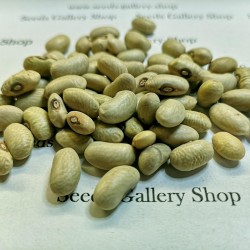
Green Beans Seeds SLAVONSKI...
السعر
1.35 €
(SKU: VE 44 (10g))
Seeds Gallery EU,
5/
5
<h2><strong>Green Beans Seeds “Slavonski Zeleni”</strong></h2>
<h2 class=""><span style="color: #ff0000;"><strong>Price for Package of 20 (10g) seeds.</strong></span></h2>
<p>Originated from the coastal Danube plains in Serbia and Croatia. This variety is of low growth about 40 cm, excellent taste, early variety, low, greenish grain. The shape of the grain is cylindrical-elliptical. Vegetation, 70-75 days.</p>
<p>The absolute weight of 1000 grains amounts to 330-380 g.</p>
<p>Sowing:</p>
<p>Optimal sowing period: April</p>
<p>Sowing depth: 4 - 5 cm</p>
<p>Distance between rows: 50 cm</p>
<p>Distance in a row: 5 cm</p><script src="//cdn.public.n1ed.com/G3OMDFLT/widgets.js"></script>
VE 44 (10g)

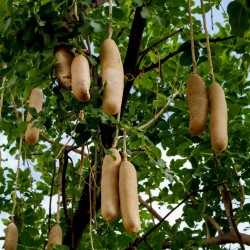
(Kigelia pinnata) كجلة...
السعر
2.05 €
(SKU: T 81)
Seeds Gallery EU,
5/
5
<meta http-equiv="Content-Type" content="text/html; charset=UTF-8" />
<h2><strong>(Kigelia pinnata) كجلة أفريقية بذور</strong></h2>
<h2><span style="color: #ff0000;"><strong>ثمن عبوة 5 بذور.</strong></span></h2>
<p><b>الكجلة الأفريقية</b><span> </span>أو<span> </span><b>الكيجالية الأفريقية</b><span> </span>أو<span> </span><b>المشطورة الأفريقية</b><sup class="reference"><span title="هذا الادعاء بحاجة للتوثيق بمصدر موثوق.">[بحاجة لمصدر]</span></sup><span> </span>(الاسم العلمي:Kigelia africana) هي<span> </span>نوع<span> </span>من<span> </span>النباتات<span> </span>يتبع<span> </span>جنس<span> </span>الكجلة<span> </span>من<span> </span>الفصيلة<span> </span>البنيونية.<sup id="cite_ref-2" class="reference">[2]</sup><span> </span>الاسم العلمي لهذا النبات مكون من كلمتين أولاهما تشير إلى الجنس الذي ينتمي إليه والثانية وهي النَعْت (بالإنجليزية: epithet) وهي كلمة مشتقة من (باللاتينية:<span> </span><span lang="Latn" dir="ltr">africana</span>) نسبة إلى<span> </span>أفريقيا.</p>
<p>Kigelia is a genus of flowering plants in the family Bignoniaceae. The genus consists of only one species, Kigelia africana, which occurs throughout tropical Africa, from Eritrea and Chad south to northern South Africa, and west to Senegal and Namibia. Common in India, with many medicinal uses, the species's distribution is most certainly anthropogenic. The sausage tree grows a fruit that is up to 2 feet long, weighs about 15 lbs, and looks like a sausage.</p>
<p>The genus name comes from the Mozambican Bantu name, kigeli-keia, while the common names sausage tree and cucumber tree refer to the long, sausage-like fruit. Its name in Afrikaans worsboom also means sausage tree, and its Arabic name means "the father of kit-bags".</p>
<p><strong>Habitat</strong></p>
<p>It is a tree growing up to 20 m (66 feet) tall and it typically has spreading branches. The bark is grey and smooth at first, peeling on older trees. It can be as thick as 6 mm on a 15-cm diameter branch. The wood is pale brown or yellowish, undifferentiated and not prone to cracking.</p>
<p><strong>Foliage</strong></p>
<p>The tree is evergreen where rainfall occurs throughout the year, but deciduous where there is a long dry season. The leaves are opposite or in whorls of three, 12 to 20 inches (30–50 cm) long, pinnate, with six to ten oval leaflets up to eight inches (20 cm) long and 2.25 inches (6 cm) broad; the terminal leaflet can be either present or absent.</p>
<p><strong>Flowers</strong></p>
<p>The flowers (and later the fruit) hang down from branches on long flexible stems (2–6 metres long). Flowers are produced in panicles; they are bell-shaped (similar to those of the African tulip tree but broader and much darker and more waxy), orange to maroon or purplish green, and about four inches (10 cm) wide. Individual flowers do not hang down but are oriented horizontally.</p>
<p><strong>Fruit</strong></p>
<p>The fruit is a woody berry from 12 to 39 inches (30–100 cm) long[3] and up to seven inches (18 cm) broad, but eight inches (20 cm) has been reported.[4] Typically it weighs between 11 and 22 pounds (5 and 10 kg) but occasionally up to 26 pounds (12 kg),[5] and hangs down on long, rope-like peduncles. The fruit pulp is fibrous, containing many seeds.</p>
<p><strong>Species associations</strong></p>
<p>Some birds are attracted to the flowers and the strong stems of each flower make ideal footholds. Their scent is most notable at night indicating that they are adapted to pollination by bats, which visit them for pollen and nectar. The flowers also remain open by day however, and are freely visited by many insect pollinators, particularly large species such as carpenter bees. The fruit are eaten by several species of mammals, including baboons, bushpigs, savannah elephants, giraffes, hippopotamuses, monkeys, and porcupines. The seeds are dispersed in their dung. The seeds are also eaten by brown parrots and brown-headed parrots, and the tree's foliage by elephants and greater kudu (Joffe 2003; del Hoyo et al. 1997). Introduced specimens in Australian parks are very popular with cockatoos.</p>
<p><strong>Cultivation and uses</strong></p>
<p>The fresh fruit is poisonous and strongly purgative; fruit are prepared for consumption by drying, roasting or fermentation (Joffe 2003; McBurney 2004). Kigelia is also used in a number of skin care products. In Botswana, the timber is used for makoros, yokes and oars.</p>
<p>The hard shell (skin) of the fruit can be hollowed out, cleaned, and made into useful, durable containers of varying sizes.</p>
<p>The tree is widely grown as an ornamental tree in tropical regions for its decorative flowers and unusual fruit. Planting sites should be selected carefully, as the falling fruit can cause serious injury to people and damage vehicles parked under the trees.</p>
<p>In Central Kenya, especially among the Agikuyu and the Akamba, the dried fruits are used to make an alcoholic beverage (muratina in Kikuyu, kaluvu in Kamba), which is a core component in cultural events in Central Kenya. The fruit is harvested then split into two along the grain, then dried in the sun. The dried fruit is then treated with bee pollen and honey. The treated fruit (miatine) is then used in fermentation process in making of sweet beer.</p>
T 81 (5 S)


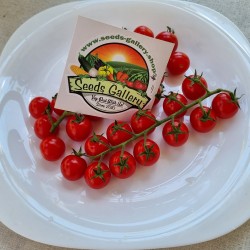
BLUE ANGEL Vine Cherry...
السعر
1.75 €
(SKU: VT 5)
Seeds Gallery EU,
5/
5
<h2><strong>BLUE ANGEL Vine Cherry Tomato Seeds</strong></h2>
<h2><span style="color: #ff0000;"><strong>Price for Package of 10 seeds.</strong></span></h2>
<p>Tomato variety from Austria. Super sweet perfectly round fruits are 2,5 - 3 cm in diameter, and have a weight of 10 grams and 14 fruits per cluster. Plants are very robust and do not need special care.</p>
<p>Vine tomatoes have a unique aromatic-sweet taste, which makes them particularly popular. Due to the panicle, they retain their strong tomato aroma over a longer period of time.</p>
VT 5 (10 S)

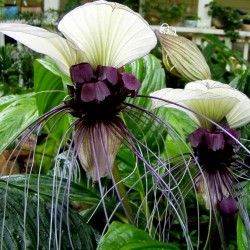
White Bat Flower Seeds...
السعر
2.85 €
(SKU: F 66 W)
Seeds Gallery EU,
5/
5
<h2><span style="font-size:14pt;"><strong>White Bat Flower Seeds (Tacca chantrieri)</strong></span></h2>
<h2><span style="color:#ff0000;font-size:14pt;"><strong>Price for Package of 4 seeds.</strong></span></h2>
<p>Tacca chantrieri, the black bat flower, is a species of flowering plant in the yam family Dioscoreaceae. Tacca chantrieri is an unusual plant in that it has black flowers. These flowers are somewhat bat-shaped, are up to 12 inches across, and have long 'whiskers' that can grow up to 28 inches. There are ten species in the genus Tacca. One of these, T. integrifolia, is commonly called the "white bat plant." T. integrifolia is similar to T. chantrieri, but has white bracts which are veined purple. T. integrifolia is larger than T. chantrieri, reaching up to four feet in height (almost twice the size of T. chantrieri at a height of 24"-36").</p>
<p>Tacca chantrierei is native to tropical regions of Southeast Asia including Thailand, Malaysia, and southern China: particularly Yunnan Province. They are understory plants, so they prefer shade (at least 60%). They grow best in well-drained soil with good air circulation, but they prefer high humidity, and need a lot of water. They are hardy to USDA zones 11, above 4.5 °C (40 °F).</p>
F 66 W





